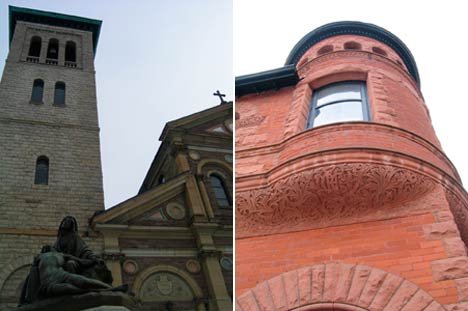
East End

Enzo DiMatteo
You have to look a little harder, but there’s architectural greatness in the east end, too. Think Old Town, the area around the regal Flatiron and legendary St. Lawrence Market. Further north, there’s the Bank of Upper Canada (chartered in 1821), and a few steps from there the city’s first Post Office and history-making St. Lawrence Hall. Veer toward Corktown and the Distillery District and beyond that to the port lands and you’ll find the most interesting examples of commercial-industrial buildings in the city – among them the 1899 Consumers Gas plant, currently occupied by 51 Division – as well as the old Cherry Street Hotel. Is there a sweeter-looking edifice the other side of Yonge? The East also lays claim to the R.C. Harris Water Treatment Plant, the perfect melding of function and form, as well as historic churches around which T.O.’s first communities grew – St. Paul’s basilica, the Cathedral Church of St. James, Metropolitan United and St. Michael’s Cathedral. Set off northward and the manses of Jarvis – reflecting nicely off the glassy new home of the National Ballet – give way further east to the cottages of Cabbagetown and the irrepressibly dark beauty of the Don Jail. A few modern wonders still dot Don Mills. And just when you think there’s nothing left, Scarborough surprises further east include the Guild Inn, spooky St. Augustine’s Seminary and the clapboard Hillside Church opened in 1877. The East is enlightening.
West End

Enzo DiMatteo
It’s hard not to be more partial to the West’s architectural surroundings. The brutalist-before-its-time World War I-era blocks make a lasting impression. As do the tidy Victorians and Tudors in and around Wychwood and Hillcrest Parks. The west end has it’s share of intriguing pockets – the CNE Grounds and Junction warehouses, for example, or Parkdale balconies. And, surprise, the campus of York U, the last great collection of modern buildings left in the city. The former Asylum in Mimico and walled stretch of manses along Lake Shore around Royal York are notable diversions. But the West’s true architectural brilliance begins to show itself at the foot of the financial district with the Dominion Public Building, Union Station and the Royal York Hotel and the inscribed limestone of the Bank of Nova Scotia on King West. Before the ivy-covered Gothic glory at U of T emerges over Queen’s Park, there’s the glassy and wondrous Terrence Donnelly Centre and new and old City Hall on which to feast your eyes. And, of course, Will Alsop’s unforgettable OCAD flyer and Frank Gehry’s revamped AGO. Awesome. Other modern beauties crop up here and there. An unlikely charmer is the 50s-era former City of York municipal building looking over the Eglinton flats. But no discussion of design would be complete without mention of the CN Tower and the unimaginable heights scaled back in the 70s to build it. More than a feat of engineering, the CN Tower transcends architectural beauty. It’s the bold arrow sticking up in the sky like one big FU that announced Toronto’s arrival as a global city.

Enzo DiMatteo












